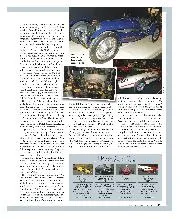

Past and presence
Parisian winter exposition assembles an impressive array of wings, wheels and props Transport of all hues turns up at Retromobile, the annual Paris extravaganza. Greeting visitors this year was the…
Spor[ing Cars on [he Road
THE 2-LITRE SUPERCHARGED LAGONDA SINCE its introduction in 1925 the 2-litre model Lagonda has met with increasing and the steady demand for a similar vehicle an even higher performance has led to the of the supercharged model which we have recently an opportunity of trying on the road and on Brooklands. The main
features of the chassis are, of course, similar to the wellknown 2litre, and this means that the engine has already had 5 years trial in addition to the very exhaustive tests which have been carried out before. offering the supercharged model to the public. The blower is a Zoller which has been found to give excellent results, especially at low engine speeds. The purpose of fitting a blower was not primarily to increase the maximum speed, although it has actually done so by some 12 m.p.h., but chiefly to improve the acceler ation and power at medium revs. This has been achieved to such an extent that even the most optimistic advocate of supercharging would be somewhat astonished at the performance of this engine. Although only of 2-litre capacity (the four cylinders having a bore and stroke of 72 mm. and the sufby beused drive a paraand car, in and gives the of litres two On the c c asion our test took op- of having a look round the works to sec the ponents both during manufacture and when completed. The standard of finish of every part is extremely high, and all materials are subjected to special tests in addition to the finished article. The crankshaft is extremely stiff various corn
and fully balanced, the method of attachment of the balance weight to the shaft being ingeniously carried out, in such a manner that they become virtually part of it, and it would be impossible for them to shift in any way.
The detachable cylinder head has hemispherical combustion chambers, fully machined to a high finish, and the inclined valves are operated by rockers from the two overhead Camshafts. Adjustment of the valve clearances is set by rotating the fulcrum pins which are eccentric, thus giving a very fine adjustment without trouble.
An excellent feature from the point of view of the owner who likes to do his own decarbonising, is that the cylinder head can be removed without disturbing the timing, thus shortening operations considerably. Pressure lubrication to all engine parts ensures a long life.
The clutch is a single dry plate, and is fitted with a very easily adjustable clutch stop. The adjustment can be reached by simply removing a floor board, and can be set in a few minutes to suit any driver’s individual requirements. The saving of time in changing up through the gears is considerable, and with the stop set fairly tight we found it possible to go through all the upward changes as quickly as we could move the lever.
A visit to the Lagonda works would be of great interest to any car owner, as the firm make everything under their own roof which is economically advisable. That is to say they make everything except such components as are completely specialised productions, such as carburettors, magnetos, radiators, and various pressings and parts which are only made in large quantities by a few well-known firms. It is noticeable that in all these cases price is not the first consideration, for, knowiug that a sports car will have a great deal of hard work, components are only used which have proved their ability to stand up to the work involved.
On driving the car we were immediately struck by the fact that it felt much smaller than it looked, and on a twisty road one could definitely “chuck it about” as if it were half the weight it actually is. This is a point which one does not always expect to find on a full 4seater, even though it is a sports car, and it shows how thoroughly the makers have got down to the problem of steering and road-holding. The steering is light but with ample caster and the car can be held on indifferent surfaces without effort.
Another remarkable thing about this engine is the amazing flexibility and smoothness, which fully bears out the statement in an article on supercharging which appeared in our last issue. In this it was pointed out that supercharging, correctly applied, solves the problem of distribution, and makes an engine considerably smoother than it was when unsupercharged. This has happened in the case of the Lagonda, and it has made what was already a very nice sports car, not only considerably faster, but even smoother throughout the range.
The 2-litre supercharged Lagonda is definitely a fast car at all speeds. By this we mean that it not only has a high maximum speed, but that owing to its fine acceleration and excellent handling, it can safely maintain a speed under adverse conditions of road and gradient, which would be difficult or impossible on some cars with the same maximum speed.
Under modern road conditions the ability to get to 70 or 80 m.p.h. quickly is of far greater value than the attainment of a considerably higher speed only after a long time, and it is in this way that the Lagonda excels. Acceleration from a standing start, using the gears, gave us 30 m.p.h. in 5 secs., 40 m.p.h. in 9 secs., 50 m.p.h. in 12 secs., and 60 m.p.h. in 18 secs., while the maximum speed achieved was 92 m.p.h. We kept the car on full
throttle on Brooklands for some laps without even getting it really warm, while it held 90 m.p.h. on the level absolutely tirelessly. From a standing start, the test hill was climbed in 12 secs., which is a very good performance indeed for this type of car. 80 m.p.h. can be reached in third gear, and there is no fuss or vibration at any engine speed. These properties really make it two cars in one. When feeling lazy and in no hurry, one can go about continually
in top gear, slowing down to 6 m.p.h. in traffic, and picking up again without a sign of roughness or pinking. Then when speed is required, a flick of the gear lever, a gentle pressure on the throttle, and almost racing car performance is available. The bodywork as well as every feature of the chassis, is of the very highest class, and at 2775 complete the car is an amazing achievement, and we are not surprised to learn That the demand has greatly. exceeded all expectations.



